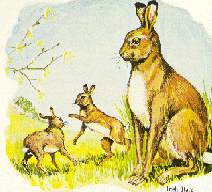
 Irish Hare(Giorria
Éireannach)-:
There
are two types of hare found in Ireland - the Brown Hare and the Irish
Hare. The Brown Hare came to Ireland from Europe, while the Irish Hare or
Blue Hare is native to this country.The blue hare is also found in parts
of Scandinavia and Scotland.
Irish Hare(Giorria
Éireannach)-:
There
are two types of hare found in Ireland - the Brown Hare and the Irish
Hare. The Brown Hare came to Ireland from Europe, while the Irish Hare or
Blue Hare is native to this country.The blue hare is also found in parts
of Scandinavia and Scotland.
Unlike rabbits they normally do not burrow. In order to get food they must leave their home You can see the hare out during the day, but most often they can be spotted at night as they look for food. They eat mainly grasses and vegetation and are known to use their large front teeth to gnaw at young tree shoots. Hares breed throughout the year, but they are more likely to breed during the Spring.
The
saying ‘as mad as a March hare’ refers to the antics of the male hare
during the breeding seasons. Each
hare tries to impress the female hares, hoping that they will be picked as
her partner, over other hares in the area. A female hare can have more
than one litter per year. Each litter can have two or three young hares.
A young hare is called a leveret.
The female will spread her litter between several forms, and visit
each one to feed her young.
The
number of hares in Ireland is small and are a protected animal under the
Wildlife Act of 1976.
Ian Daly